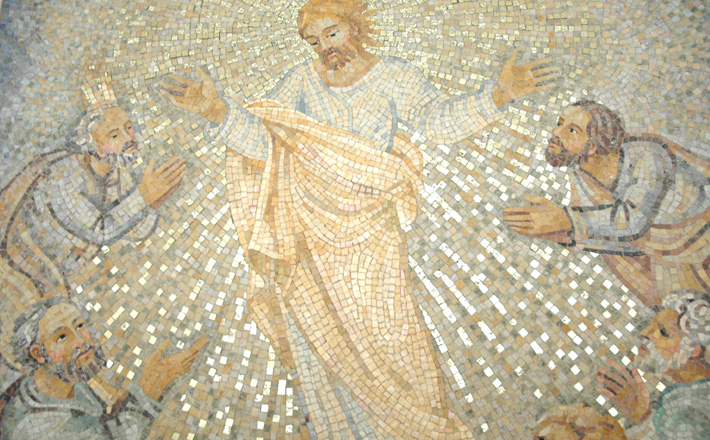Commentary on Luke 9:28-45
Transfiguration is one of those festivals, like Christmas and Easter, that seems, the longer I am at this preaching business, harder to preach.
What more, what new is there to say about it?
This essay will probably not be chock full of new material, but I hope to offer a couple of observations that might help with a fresh take on this familiar story.
First, it is interesting to note that in Luke there is not actually a “transfiguration.” What?! you may ask. That’s right, at least insofar as the word itself is concerned. Unlike in Mark and Matthew, the word “transfiguration” (metamorphosis) is not used by Luke. Mark and Matthew both say that on the mountain, “he was transfigured before them.” Luke, in contrast, describes what is clearly the same event, by saying that, “the appearance of his face changed,” literally “the appearance of his face became other” (egeneto ‘eteron). While Mark and Matthew say that Jesus was transfigured, a fairly complicated theological concept, Luke seems more interested in describing what is happening. In classical terms the transfiguration is a theophany, God showing up, appearing. Here in Luke, God both shows up to Jesus in a sense, and shows up in Christ Jesus—on a mountain, again, as God appeared to both Elijah (1 Kings 19) and Moses (Exodus 33) once before—with Christ’s divinity “peeking through.”
What is striking here is that Elijah and Moses get front row seats to another theophany. When God appeared to Moses, God did so at Moses’ request, “Moses said, ‘Show me your glory, I pray’” (Exodus 33:18). And God did. Just God’s back, because Moses couldn’t have seen God’s face and lived, but it was clear to Moses that he was in God’s presence. And Elijah? Not a “full” theophany, exactly, but a “sound of sheer silence” that was, it seems, unmistakable. Now Moses and Elijah are there again. This cannot be an accident.
What is more, in both Mark and Matthew when Moses and Elijah appear, the summary is that they are talking with Jesus; no other detail is given. Not so in Luke. In Luke, we learn that they are discussing, “his departure, which he was about to accomplish at Jerusalem.” What this revelation does is to highlight the central place that the transfiguration (or the “becoming other”) has in Luke’s Gospel.
In fact, one might argue that the transfiguration is the exact center of the Gospel of Luke. It both echoes how the story began, and foreshadows how it will end.
Looking Back
As Peter, James, and John are there on the mountain with Jesus, we read that, “a cloud came and overshadowed them.” This is reminiscent of what the angel says to Mary in the annunciation. In answering Mary’s question about how it is possible that she will bear the messiah, as she is a virgin, the angel says, “The Holy Spirit will come upon you, and the power of the Most High will overshadow you” (Luke 1:35). The overshadowing is the first reminiscence of the transfiguration to the beginning of Jesus’ story. But there is more. The angel goes on to say, “ … therefore the child to be born will be holy; he will be called Son of God.” And then, when he is baptized it comes again, “This is my Son, the Beloved,” an address that is matched here on the mount of the transfiguration, “This is my Son, my Chosen, listen to him.”
Looking forward
Two more mountains are in Jesus’ future: the Mount of Olives and Golgotha. On the Mount of Olives, Jesus is again accompanied by his disciples (again, they are sleepy), and again he goes up the mountain to pray. And at the mount of the crucifixion, Jesus is, again, not alone. He has two men with him; not Moses and Elijah, but two criminals. Perhaps most importantly, on that mountain Jesus is transfigured again. He is shown to be a different kind of messiah than the disciples are expecting or ready for. On the mount of the transfiguration, we catch a glimpse of the divinity of Jesus, literally shining through. But in the crucifixion, we catch a glimpse … more than a glimpse … of what, in Christ Jesus, that divinity is for. It is for us.
When Jesus is finally revealed in his glory, we learn that his glory is not what we think we see.
His true glory is other; something else altogether than.
His true glory looks an awful lot like glory’s opposite.
His true glory is not to be found in a changed face or clothes of dazzling white, but outstretched arms and bloodied hands and feet.
The transfiguration, lying at the center of Luke’s Gospel, points both backwards and forwards, drawing the gospel story together, from its humble beginnings, to its completely “other” conclusion.
PRAYER OF THE DAY
Dazzling Lord,
In blinding light you showed your disciples a hint of your power and purpose. Reveal yourself to us today. Show us what you desire of us and how to broadcast your love to the world, for the sake of the one who keeps company with the prophets Moses and Elijah, Jesus Christ our Lord. Amen.
HYMNS
How good, Lord, to be here! ELW 315
Oh, wondrous image, vision fair ELW 316, H82 136, 137, UMH 258, NCH 184 Jesus on the mountain peak ELW 317
Shine, Jesus, shine ELW 671
CHORAL
The Exaltation of Christ, Charles Forsberg


February 14, 2021